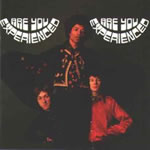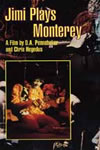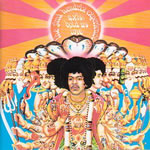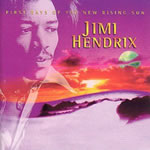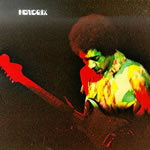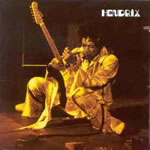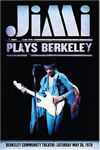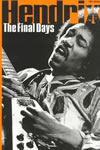Jimi Hendrix is undoubtedly the most influential electric guitarist the world has ever seen. Others may have been quicker — as Pat Metheny put it, the 70s were about trying to play as fast as John McLaughlin, and finding it was impossible — and there have been many guitar players with great licks, or who have given electrifying performances. There have been many marvellous guitarists, but Jimi was the very embodiment of the instrument.
His oneness with the guitar is obvious in performance, from his first filmed gig at Monterey, in June 1967, to his last at the Isle of Wight, in August 1970. His whole body bent and swayed to press sounds from the fretboard. His mouth followed each note. His elegant hands pulled trills from the strings, and shook them like drops of nectar into the air. If inspiration has ever been physically exemplified, then it was through Jimi Hendrix. Quiet and polite in interview, he was possessed of the spirit of music on stage.
Jimi was born in Seattle, in the Northwestern US, near the Canadian border. About as far from the Delta heartland of the Blues as England. Seattle is also over two thousand miles from Chicago, the focus of Urban Blues. Seattle was not a great Black settlement, so Jimi had about as much contact with Blues culture as did his great English contemporaries — the likes of Clapton, Page and Beck.
Jimi was born on 27 th November, 1942 . His parents were dancers. His mother left him with an aunt, and he was picked up by his dad, Al, nearly three years later, when he returned from the War. Al changed his son's name from John Allen to James Marshall Hendrix. Jimi's parents separated when he was small, leaving him, and younger brother Leon, in the care of their dad. Jimi's mother, Lucille, visited from time to time. While Al settled down to life as a gardener, Lucille played out her life as a party girl. Jimi was greatly affected by her early death, when he was only fifteen.
Jimi grew up in poverty, sometimes going without shoes. He began his lifelong obsession with music at four by picking up a harmonica. He arrived at guitar via violin and ukelele, but travelled the route almost entirely self-taught. Jimi Hendrix didn't read music, let alone attend a conservertoire, even so, he has been as influential as any other member of his generation, perhaps more so.
He left Garfield High School without graduating. In 1961, there was a court appearance, because Jimmy - as he still was - had joined some friends for a couple of joyrides. A stern judge gave him the choice between a custodial sentence and a stint in the Forces. So at seventeen, the supposedly prototypical hippie joined the 101st Airborne, the Screamin' Eagles. He spent thirteen months in the Army, until on his 26th parachute jump he broke his ankle, and was given an honourable discharge. There is no doubt that in the paranoia of the Nixon era Hendrix would have been ordered to Vietnam, if he hadn't already served his time. He later gave his succinct opinion of the military life, saying, 'I hated the army immediately'.
While in the Army, Jimmy played in the King Kasuals with a saxophonist major, bass player Billy Cox, and guitarist Larry Lee. After leaving the Army, he and Cox played in pick-up bands in Tennessee. Hendrix moved on to New York. He played as a sideman in a variety of bands, including a stint with both Ike and Tina Turner, and the Isley Brothers. It is said that Little Richard — already past his greatest success — threw Hendrix out of the band for upstaging him. It was a meagre existence. Sometimes he had to sleep on the street, and he kept his guitar in a potato sack.
After a while in ex-Inkspot Curtis Knight's Squires, Hendrix fronted his own band under the name of Jimmy James and the Blue Flames. The band included Randy California, later to form Spirit, and a subsequent Doobie Brother, as well as notable white bluesman John Hammond, jnr. By this time, Jimmy James was being promoted by Linda Keith, the model girlfriend of Rolling Stone Keith Richard.
Linda Keith spoke of Hendrix's terrible lack of confidence, and his indecision. Recognising his exceptional talent, she determined to find him a manager. She felt sure that Stones' manager Andrew Loog Oldham would be perfect. Linda Keith surreptitiously borrowed a Stratocaster from her boyfriend, but as she said, Oldham 'thought Hendrix was a wild man who just didn't have it.' Her next attempt was Seymour Stein, who also refused to sign Hendrix.
They were about to give up, when, quite by chance, Keith met Chas Chandler, the Animals' bass player. Chandler was sick and tired of life on the road. Despite the Animals' remarkable chart success, he was making very little money. Chandler was going to form his own company. It wasn't quite what Linda Keith had wanted for her protégé, but it would have to do.
Chas Chandler thought Hey Joe could be a hit. He was surprised and delighted to find that Hendrix had already made his own arrangement. When Chandler offered to take Hendrix back to England, the guitarist had one question — could Chandler introduce him to Eric Clapton?
A passport was arranged — Hendrix hadn't left the States before — and within weeks they were on a plane to London. On that plane a momentous decision was made: at Chandler's suggestion, Jimmy James became Jimi Hendrix. Chandler kept his word, and within a week of their arrival, on October 1st 1966, Hendrix was playing with Cream. Legend has it that Clapton left the stage after just a few bars of Killing Floor, pale and too shaken to light a cigarette.
Unwanted by the US music industry, Hendrix found soulmates and success in the burgeoning British Blues scene. The leaders of that scene shared his respect for the great stars of the Blues — already considered old-timers by their almost exclusively Black audience in the States. Soul was the hip music in that community.
Before he had even recorded, Jimi was attracting such luminaries as the Beatles, the Stones, and the Who to his gigs. Auditions provided a reluctant bass player in Noel Redding (he needed the pay check, but always wanted to get back to his own guitar playing), and a toss up between two excellent drummers — Aynsley Dunbar and Mitch Mitchell. Mitchell got the gig, and Dunbar joined John Mayall's Bluesbreakers, before crossing the pond to play with Frank Zappa's Mothers of Invention.
The Jimi Hendrix Experience played the usual run of dives, in a clapped-out van, before hurtling to success with a series of remarkable singles. Chandler hot-housed Hendrix, providing him with confidence. Jimi's girlfriend, Kathy Etchingham, undoubtedly provided vital support, too. Hendrix read through Chandler's collection of science-fiction, played Risk with all-comers, and Twister with Kathy. He wanted to put the Soul standard Land of a Thousand Dances on the flip side of Hey Joe, but Chandler wouldn't hear of it. He told Hendrix to write something new — probably conscious that the Animals' financial slim rewards were mainly due to their lack of original material. Stone Free was the result, and, with Chandler 's encouragement, new material streamed out of Hendrix — probably based upon guitar riffs he had been developing over the years.
Hey Joe, Purple Haze and The Wind Cries Mary all charted in Britain in the Spring of 1967. As was the practice of the time, the singles, and their flip sides, were kept off the subsequent album, so by May 1967 when Are You Experienced? was released, Hendrix had produced a slew of new and exceptional material — some seventeen songs in all, nearly all of them classics. Paul McCartney helped the Mommas and the Poppas finance the Monterey Pop Festival on condition that Hendrix would perform there. Brian Jones of the Rolling Stones flew over, just to introduce him, and in one gig the US was conquered. Thankfully, that gig was recorded on film. Hendrix and Track Records' stablemate Pete Townsend had argued about who would go on first. Both the Experience and the Who were impossible acts to follow. Jimi proceeded to burn the house down, and then burn his guitar, too. This was believed by many to be a trademark in his performance, but it only actually happened on one or two other occasions. But the real trademarks are all there — the flickering tongue, the sexual magic of the guitar, playing behind his back, between his legs, and with his teeth. Most of all, the sound is there, the absolute fusion of man and guitar. English engineer Jim Marshall had provided the amps for Hendrix's startling new feedback sound.British Blues musicians took the music seriously, for the most part, but Hendrix's brilliant stage tomfoolery went right back to the beginning of the music. Charley Patton, who was to influence every bluesman, combined fine musicianship with performing high jinks. It was all part of the trade.
Are You Experienced? was now successful in the States, though minus Hendrix's wonderful Blues Red House. Because he finished the song by saying that if his girlfriend won't love him then her sister will, the record company feared the censors. This was quite some time before NWA and Snoop.
Hendrix was kept to a ridiculous schedule of gigs, interviews, and recording sessions. A former member of the British Secret Service ran his equally secretive management company, stashing the money in overseas accounts. The excellent Axis: Bold As Love was released at the end of 1967, and once again straddled genres. Hendrix was capable of the raunchiest Rock, and the most delicate Jazz. He was no stranger to Soul either. His mother, Lucille, who had died ten years before, was a constant inspiration. Waterfall, the spellbinding Little Wing (and later on the beautiful Angel) came from his memory of her. There were also many themes from Chandler's sci-fi collection, and a smattering of Eastern mysticism. Hendrix was already dissociating himself from the hippie movement that had taken him to heart. He was no advocate of conformity, even to supposed non-conformism. If Six Was Nine exemplifies his determined individualism.By the time Electric Ladyland was released, in October 1968, Hendrix and Chandler had parted company. Hendrix wanted to move back to the US, and he was tired of the three minute limit of the pop song. He recorded the entrancing 1983...(A Merman I Should Turn to Be) and Moon Turn the Tides...gently, gently away, in all nearly 15 minutes long, immediately after their parting.
Much of the Hendrix fortune was being deployed into the completion of the Electric Lady studios, in New York. Without Chandler pushing him ahead, Jimi settled into a life of jamming, and labyrinthine recording. Some commentators have opined that he was burned-out creatively, but this is an obvious nonsense. He was recording tracks for The First Rays of the New Rising Sun. Some of these would appear on the posthumous albums Rainbow Bridge and Cry of Love, before eventually being reconstructed into something close to the album he had intended, and released under his original title. There is no lack of creativity in these tracks, and the production values — especially where Hendrix was able to complete the tracks — are a progression even from his earlier, excellent work. Hendrix, in fact, created a form of music barely explored since his tragic death. Possibly because no-one else has ever been able to assimilate Rock, Blues, Soul and Jazz as naturally as Jimi Hendrix.Relations with the Experience's bassist were strained. Noel Redding had his own career to pursue, and had become so bored waiting to lay down tracks for Electric Ladyland that he had sometimes simply wandered off to the pub. Hendrix decided to ask his old Army buddy Billy Cox to join the new band. All he had left was the phone number of a grocery store used by Cox for messages. When they spoke, Billy Cox had no idea that the superstar Jimi Hendrix was his old musical partner.
Cox joined the band, and all of the subsequent recordings show that he gave a new dimension to the music with his agile, note-perfect playing. He also allowed Mitch Mitchell a vigorous foundation for his own flamboyant explorations. Sadly, moving from the chitlins circuit in Tennessee into the international spotlight proved to be emotionally overwhelming by the end of his time with Hendrix. It is amazing that anyone withstood the pressure.
Hendrix emerged briefly with a gang of friends, including Cox and Mitchell, to play Woodstock in August 1969. Due to a mix up by the promoters, this headlining act ended up playing to the rising sun, the morning after the festival had officially finished. Consequently, Gypsy Suns and Rainbows, as Hendrix called the outfit, played to a residue of about 25,000 people. But film of the event houses an astonishing version of Star Bangled Banner, and a beautiful jam, set around Villa Nova Junction. Luckily, Hendrix's sound engineer, Eddie Kramer, was on hand to capture the gig.
Hendrix was beset by legal problems arising from unfair contracts he had signed before meeting Chandler. Capitol Records had bought one of these contracts, and after legal wrangling accepted a single Hendrix album as settlement. On New Year's Eve 1969, and New Year's Day 1970, Hendrix played two concerts each night at the Fillmore East along with Billy Cox, and drummer and vocalist Buddy Miles. Hendrix selected and mixed the tracks for the album — Band of Gypsys — and the remainder were then lost for decades. They can now be bought on Live at the Fillmore East, which adds two more renditions of Machine Gun to the exceptional version on Band of Gypsys. At the end of May, 1970, the new trio with Cox and Mitchell played the legendary Berkeley gigs. Film of the first gig has at last become available on DVD, with the second gig in audio on the same disc. This is undoubtedly the best filmed Hendrix performance. At Woodstock, the audience had mostly left, and the band was beyond decent recording (there is almost nothing audible of the two percussionists, who can be seen enthusiastically accompanying Hendrix); the Isle of Wight was a logistical nightmare, despite Hendrix's determination to produce a show; Monterey shows off the early Hendrix in fine form; a London Albert Hall gig still awaits release, but the audio isn't as impressive as Berkeley, which takes him into his own personal territory, the creation of soundscapes, to this day unobtainable by other guitarists, despite a plethora of new effects and gismos. In August 1970, Hendrix was mixing tracks for First Rays, when he had to leave his new studio for a European tour. By this time, he was the highest paid performing musician in the world, bar none. As usual, his management booked him into a gruelling schedule of gigs and interviews (these last can be seen in Tony Brown's excellent Hendrix — the Final Days). Jimi fulfilled his obligations, despite having a 'flu bug, and the disintegration of Billy Cox's psychological health. Cox was sure that something dreadful was going to happen, and, of course, he proved to be right. Cox, not a user of psychedelics, was spiked with LSD. He had to be flown back to the US with a psychiatrist.In the early hours of September 18th , after a protracted argument on the street a few hours before, Monika Dannemann tracked Hendrix down to a party and insisted over the entrance intercom that he should take her home. Jimi had interviews the next morning, so asked her for sleeping pills. She gave him a huge overdose of her prescription barbiturates. She woke early and watched his death agonies for several hours before calling an ambulance. Contrary to her statements — believed and reported by many writers — Hendrix was dead when the ambulance arrived. Ten days later, a London coroner gave an open verdict on his death: this meant that the coroner did not feel that there was sufficient evidence to say whether Hendrix's death had been accidental or deliberate, leaving the case open for further investigation.
Shortly before his death, Hendrix had asked producer Alan Douglas to work with him. So, Douglas took on the legacy — a huge array of pieces in varying stages of completion. Jimi's father, Al, was fobbed off with an insulting payment, and the money-men set about cashing in on their assets. Sound engineer Eddie Kramer and drummer Mitch Mitchell did a pretty good job with most of the finished and near finished material for the proposed First Rays of the New Rising Sun album, issuing them as Cry of Love. Under Douglas' direction, Hendrix tapes were pulled apart, backings that he had approved were overdubbed, live recordings were issued without being cleaned. Hendrix had become a commodity, and there was no let up in demand. The film Rainbow Bridge was released, showcasing an uninspired gig in Hawaii. The accompanying album featured tracks from Berkeley instead. A hastily cut version of Jimi Plays Berkeley toured the cinemas. Then, Hendrix's manager, Michael Jeffrey, died in a plane crash, and the Hendrix estate descended into chaos.
Eventually, after serious legal intervention, Jimi's father, Al, regained the rights to the estate. Experience Hendrix was formed, and after hiring Eddie Kramer, the engineer on many of the recordings, began to systematically issue the remastered catalogue. Many treasures have come to light, and the dire first CD releases have been replaced.
It has been said that there are over 180 hours of taped material made by Hendrix himself. He often carried a tape recorder around the clubs, jamming with whoever would play. Perhaps one day we will hear his legendary jam with John McLaughlin. Bootleg live recordings are also being cleaned up and released by Experience Hendrix.
Now, of course, the Hendrix family is caught in litigation again. Al Hendrix remarried, and with his death the estate passed to his wife's daughter, Janie. Jimi's brother, Leon, and several other relatives are sueing for a share of the estate. Hopefully, these suits will not impede the release of the remaining material from the vaults.
It is a dreadful tragedy that Jimi Hendrix only had four years of recording, but a virtual miracle that so much of his music has survived — given the general hostility of the music industry towards music ('We're in business to make money...'). It is strange to think that more than thirty years after his death, new material is still appearing: 2003 at last saw the release of a properly edited DVD film of the Berkeley gig, including the second show in audio. Jimi Plays Berkeley remains fresh and vitally new to this day.
Jimi Hendrix preached racial and religious tolerance. He spoke of a new spiritual unity based upon the language of music rather than speech. He called this new way of living the Electric Church. Whenever you listen to his music deeply, you enter that Church, and Jimi Hendrix still lives, his life fulfilled by your participation in his work.
February-May 2004
